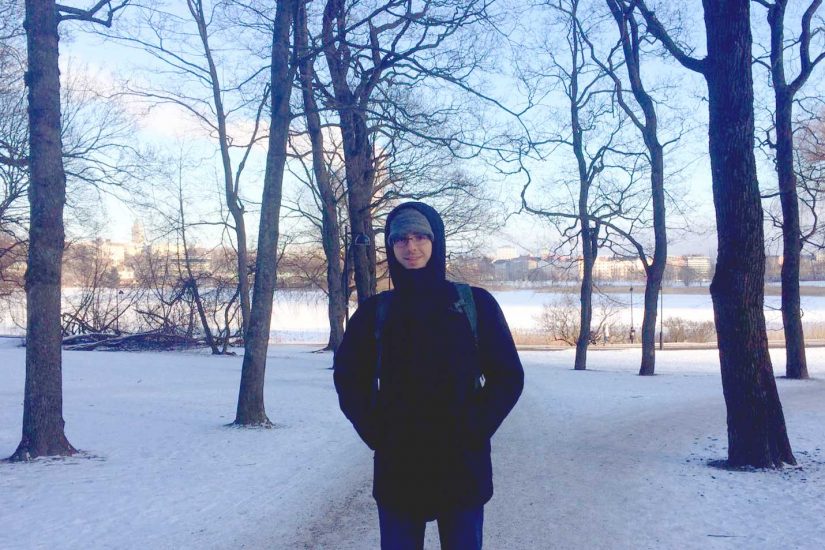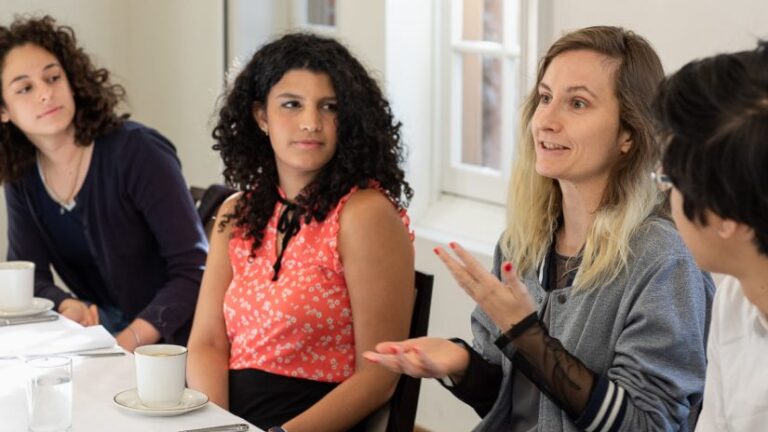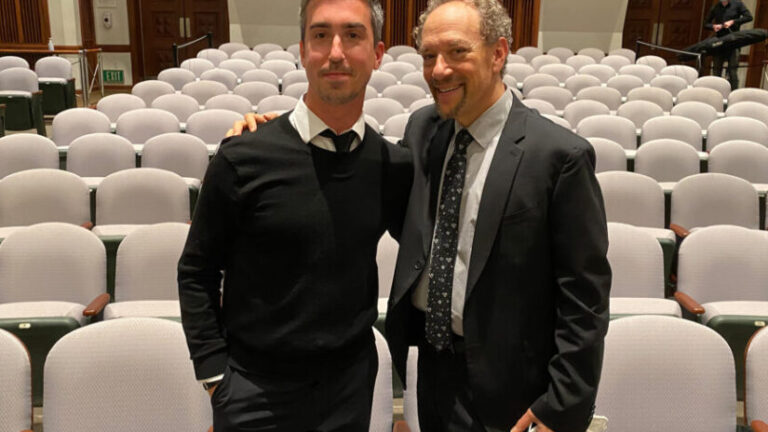
Curtis Green dressed for Finnish winter. (Photo/Courtesy of Curtis Green)
USC Thornton sends first student to Sibelius Academy in Finland for a trailblazing new music exchange program
Curtis Green traveled to Helsinki as USC Thornton welcomed Sibelius Academy student Veera Vallinkoski, a music production major, to LA.
American music students traditionally have few chances for global study, but USC’s music school wants to change that.Curtis Green, a jazz pianist raised in New York City, came to USC to train for a career in film composing. That plan took a detour when he became the first exchange student at the Sibelius Academy in Finland — a program established with the USC Thornton School of Music.
Green traveled to Helsinki in January as USC Thornton welcomed Sibelius Academy student Veera Vallinkoski, a music production major, to the University Park Campus.
“Because of strong ties to individual teachers who provide one-on-one training, American music students traditionally have had few chances for international study,” said USC Thornton Dean Robert Cutietta. “USC Thornton is striving to be the first school in the U.S. to overcome this hurdle institutionally, and we have several new initiatives underway.”
Three years ago, the school became a founding member of the Pacific Alliance of Music Schools, which promotes connections between Pacific Rim conservatories. USC Thornton is also one of only a handful of American members in the Association of European Conservatories, a springboard for partnerships abroad.
Moving these partnerships along is Mist Thorkelsdottir, head of International Programs in the Performing Arts at USC.
“Our goal is that every USC Thornton undergraduate student will have the opportunity to seek a meaningful international experience during their four years here,” said Thorkelsdottir, who previously worked at conservatories in Sweden and Iceland.
Thorkelsdottir is currently exploring exchange programs with music schools in Germany, Austria, Norway, the Netherlands, England, France and Italy.
An American in Helsinki
Green, 20, chose USC because it’s not a traditional conservatory model of music education.
“I didn’t want to go somewhere I was going to be told to sit in a room all day,” he said.
He had attended the progressive Dalton School on Manhattan’s Upper East Side, playing piano and composing for the jazz band. He’d co-founded the school’s first all-male choir and started a collaboration between its student composers and dance workshop program. Other passions included French lit and playing basketball.
“I saw Thornton as this place where all these things I wanted to do — that I had previously thought I couldn’t put together — were going to be in total synthesis. Film, music, dance, the cultural vibe of L.A. There’s not much you can’t do here. It’s such a hybrid music school.”
Green didn’t have to go far to find his first music teacher. It was his uncle, composer Chris Curtis, creator of the 2012 Broadway show, Chaplin: The Musical.
His parents were also artists. Green’s father, Broadway singer-actor Colton Green, was in the original cast of Ragtime and Kiss of the Spider Woman. His mother, a choreographer, had been a national champion ballroom dancer.
“The first songs I learned to play,” he said, “were my uncle’s piano arrangements of movie themes. He taught me to love music first, why we love it and why it touches us.” By 13, he was playing chamber music, attending music festivals and composing his own music.
At USC, Green studies with jazz composer Vince Mendoza. He also sings with the Crescendo vocal jazz ensemble and plays regularly with his own jazz trio. He has a part-time job assisting a prominent Hollywood film composer, and this past summer he started scoring his first feature film, an independent project with a friend from the USC School of Cinematic Arts.
With his eclectic tastes and unusual musical background, Green wasn’t the most obvious candidate to be USC Thornton’s envoy at Sibelius Academy, precisely the kind of traditional conservatory he had shunned. But he was curious, and it would only be for a semester.
A dance in the mud
Helsinki turned Green’s musical assumptions and expectations upside down.
“I compose emotion-driven, filmic music,” he said. “When I hear something in my head, I don’t question it too much. If it flows through my body and feels right, it’s ready to go.”
For his first meeting with composer Tapio Nevanlinna, his mentor at Sibelius Academy, Green brought a rough orchestral sketch he’d been working on a few weeks.
Staring at the pages of score, the Finish composer had murmured: “Wow. This is music.”
Flattered, Green thanked him.
It wasn’t intended as a compliment. Nevanlinna soon made it clear that he wanted far less music and far more thought.
For the next six weeks, Green tried to oblige, drastically winnowing his output. “But Tapio kept saying, ‘Less, less, less,’” Green recalled. Midway through February, he showed up for a lesson with just four notes on his music paper.
“Yes!” Nevalinna rejoiced.
Green remembers thinking, “my God, this is insane.” Based on those four notes, however, Nevanlinna guided his American student through a painstaking compositional journey. They debated whether and how often pitches should repeat, the purpose of octaves.
“Every element was thought out — every note and every combination. A little too much thinking, in my opinion,” he maintained. “My composition felt like a dance in the mud.”
Tempted to write off the whole experience as needlessly mathematical and unmusical, Green eventually had a change of heart.
“It turned into a really beautiful collaboration and mentorship,” he said. “I’m glad that I embraced it and continue to make myself open to new ideas and new approaches. I still try not to question my musical ideas too much, but I’m really thankful for that experience with Tapio.”
Nordic ways
Finland challenged Green’s assumptions in more basic ways. The hardy New Yorker thought he knew all about winter, but found he was mistaken. After going two weeks without seeing the sun, he felt “exalted” when it finally emerged. The arctic gales that whipped away its thick cloud blanket, however, rendered Helsinki “almost uninhabitable.” Tears froze on his lashes when the mercury dipped to -20 F.
“And I was in the Miami of Finland,” he said, with a self-deprecating laugh. Helsinki lies at the country’s southern-most tip. Up north in Lapland, Celsius and Fahrenheit readings sometimes reach equilibrium. (That happens at -40, Green was helpfully informed by Finns who scorned to wear gloves in January.)
The extreme cold, Green believes, helps explain why Finns are such fine musicians. During the winter months, “there’s really nothing more you can do than sit in a practice room all day and work on your craft.”
The dreamy pace at Sibelius Academy also took Green by surprise.
“You can feel it in the way the Finnish composers talk and move through their days,” he said. “There’s a more hushed, temperate way of going about musical education.
“Finnish students have longer than is typical in America to complete their bachelor’s degree. Their education is free, and the whole time they have subsidized housing from the government.”
This low-pressure culture feeds into fundamental personality differences between Finnish and American artists.
“We’re far more focused on our careers in the United States,” Green said. “We’re more proactive. Especially at USC, everybody is so driven — so keen on promoting themselves and collaborating. It’s a very outward environment. The music environment in Finland is very calm and inward.”
At the same time, Green found Helsinki to be a cosmopolitan European music capitol. Sibelius Academy takes many exchange students, so Green was thrown together not only with Finns but with Estonians, Germans, Swedes, Thailanders and South Koreans.
Only in the United States, he realized, do music teachers insulate their pupils from external influences.
“In European conservatories, you’re expected to spend at least a year, if not more, away from your home university,” Green said. “It makes so much sense that they do that, and so little sense that we don’t here in the U.S.”
Asked if he’d recommend the exchange program, Green lights up:
“Oh, a thousand percent!” he said. “I have not heard of any other U.S. music school offering a full-semester study-abroad program. There are summer institutes and festivals around the world, but to sit in classrooms with young Finnish musicians and study alongside them? It’s an incredible opportunity, unique to USC. The fact that Thornton set up this program is evidence of how on the cutting-edge it is and how tapped-in Dean Cutietta is. I’m just glad that I got to run the torch for a little bit of the journey.”



